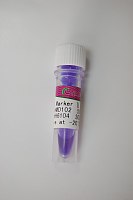Combined lmmunocytochemistry and PRINS DNA Synthesis for Simultaneous Detection of Phenotypic and Genomic Parameters in Cells
互联网
715
Primed in situ (PRINS) labeling has become an alternative to in situ hybridization (ISH) for the localization of nucleic acid sequences in cell (1 –4 ) and tissue preparations (5 ; see also Chapter 5 ). In the PRINS method, an unlabeled primer (restriction fragment, PCR product, or oligonucleotide) is annealed to its complementary target sequence in situ . The primer serves as an initiation site for in situ chain elongation using a thermostable DNA polymerase and labeled nucleotides, which can be detected directly by fluorescence microscopy, such as fluorochrome-labeled dNTPs, or indirectly using, e.g., biotin- or digoxigenin-dUTP and the application of fluorochrome-conjugated avidin or antibody molecules (3 ,6 ,7 ). The detection limit of the PRINS technique appears to be on the order of low-copy sequences (3 ,8 ).









